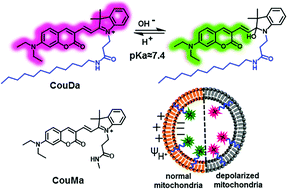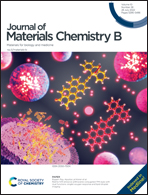A ratiometric pH probe for acidification tracking in dysfunctional mitochondria and tumour tissue in vivo†
Abstract
Cellular dysregulated pH and mitochondrial metabolism are commonly two central factors for solid tumour progression. pH regulation and long-term mitochondrial tracking provide a great opportunity for tumour treatment. pH probes with suitable pKa and satisfactory mitochondria-immobilizing character are demanded for tumour recognition and therapy. Here, we report a ratiometric fluorescent probe, CouDa, for pH imaging in mitochondria and tumour tissue. CouDa displays an obvious blue-shifted emission (about 160 nm) in alkaline environment, with a pKa around 7.4 suitable for monitoring mitochondrial pH change. NMR and MS data confirmed an addition reaction mechanism of OH− upon the positively charged conjugated structure of hemicyanine fluorophore. Mitochondrial immobilization and acidification monitoring were realized by CouDa in cells treated with a mitochondrial uncoupler. Moreover, CouDa could distinguish acidified tumour tissue in living mice. Comparing with its analogue, the pH-sensitivity and mitochondria-immobilizing property are attributed to a hydrophobic long alkyl chain on indolium N atom. This work provides an effective strategy to track nucleophilic substances in dysfunctional mitochondria.



 Please wait while we load your content...
Please wait while we load your content...